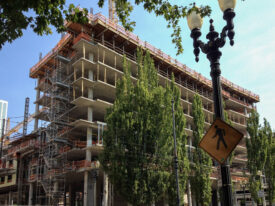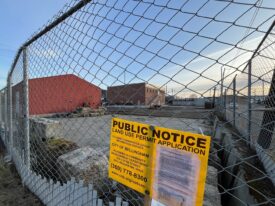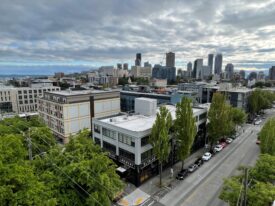Today’s Wall Street Journal includes a front-page feature on Vancouver, BC’s secondary suites and laneway houses and a video interview with Conor Dougherty, the author. The piece includes a nice Sightline quote; we were a major source for it. (Unfortunately, the full article is behind a pay wall.)
To get a sense of how America will pack more people into its cities, head north to an alley that runs behind Petersham Avenue here. That’s where Ajay Kumar built a $300,000, Moroccan-themed cottage that sits in his backyard and will soon be occupied by his parents.
Mr. Kumar’s “laneway house” is part of a broader plan that encourages Vancouver homeowners to add rental units in their basements, attics and backyards. The hope is to reduce sky-high housing costs and increase population density throughout the city—including the single-family-home neighborhoods like Mr. Kumar’s that surround the city’s towering downtown.
Cities across the U.S. and Canada are liberalizing their zoning codes to allow multiple dwellings on a single lot. Planners like these “accessory units” because they steer growth to developed land and infrastructure, reducing the cost of city services. Such housing can allow seniors to live near their children. And the dwellings are smaller and cheaper—helping cities create more affordable housing.
Few cities have gone as far as Vancouver, which has seen real-estate prices soar after an influx of domestic and foreign buyers. In many U.S. cities, citizens might not tolerate changing the rules to boost population density. But other places, including those with high real-estate prices and housing shortages, are encouraging accessory units despite resistance from some residents.
“These units are one front in a giant war for how our cities are going to grow,” says Alan Durning, executive director of the Sightline Institute, a Seattle think tank.
The article reviews trends that will be familiar to those who have read my three ADU pieces, but it fills in the landscape beyond Cascadia. It also highlights the business opportunities for builders and explains the key role of real-estate economics and shifting demographics in driving up numbers of accessory units.
The best line may be from Jake Fry, a Vancouver, BC, builder, who comments on what’s required to create small, functional living spaces, “You have to treat the house like a sailboat.”








Susan Thering
I am working with a national network to promote ADUs. We are curious to learn if you know of any difference in national housing finance policies between CA & US. Our research suggests ADUs will not be widely adopted until local banks can roll ADU construction loans into conventional mortgages and sell them up to the Fannie Mae and Freddie Mac type semi-governmental agencies. Existing polices make that impossible. Insights will be much appreciated.
Alan Durning
Thanks for your note, Susan. Elsewhere in this series, as you may know, I discuss the many legal obstacles to ADU development. I mention, for example, that owner-occupancy requirements makes it very difficult to secure construction loans.
I know little about your particular question regarding the relative importance of creating ADU loan products that can be bundled and sold like conventional mortgages.
I do know, however, that one major concern of Portland ADU developers has been appraisal valuation of ADUs. Here’s a blog post about an appraisal journal article that might interest you. Its author is a wealth of information on the subject.
http://accessorydwellings.org/2012/11/20/appraisal-journal-on-adus-and-an-editorial-on-evidence/
My recollection of argument is that conventional appraisal methods understate ADU value, making it hard to qualify for construction loans and home equity loans.
Good luck!
Chris Pollitt
I live in Vancouver and think the laneway housing initiative is a good thing. I was surprised to learn however that the tenants of these new laneway homes must be a relative of the owner of the primary home. This seems unnecessarily limiting to me.
Chris Pollitt
Also, shipping container housing is becoming a new way to create more affordable housing in Vancouver. I know of one project recently finished and that other, larger projects are in the works. See http://bit.ly/JWneD8
Chris Pollitt
Lastly, we also recently approved our first co-housing project: http://bit.ly/JWoarg